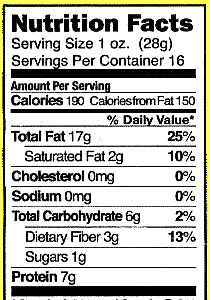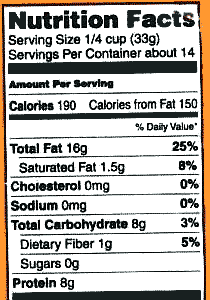The Alert Consumer
Food labels have a lot of technical information that is hard to interpret. We will compare the nutrition labels of raw sunflower seeds from two stores to try to figure out the differences. Weight ratios of fat, carbohydrate, and protein of 2:1:1 to 3:1:1 are very typical for nuts and oil seeds.
The most obvious discrepancy in these labels is the serving size of 28g for the Whole Foods seeds vs. 33g for the Trader Joe’s seeds, both of which have 190 Calories per serving. It is unlikely that a five-gram (15%) difference in the serving size would have a negligible effect on the total calories. We also notice that the Whole Foods seeds have three times the amount of fiber as the Trader Joe’s seeds, and Trader Joe’s seeds have no sugars whereas the Whole Foods seeds have 1 gram of sugars. Aren’t all sunflower seeds the same? How reliable are these “Nutrition Facts”?
Let us start with a simple check to see if everything adds up. The Whole Foods serving size is 28g, but if we add 17g of fat, 6g of carbohydrate, and 7g of protein the total is 30g. Oops! It is not unusual for the sum of the components to be slightly different than the whole due to rounding errors and unlisted components, but it is abnormal to have the components exceed the total serving size by 2 grams (7%).
The Trader Joe’s serving size is 33g. Adding 16g of fat, 8g of carbohydrate, and 8g of protein we get 32g. This is much more consistent and the discrepancy is probably due to rounding. If we had 16.3g of fat, 8.4g of carbohydrate, and 8.3g of protein everything would add up properly, but by rounding to whole numbers we would lose 3% precision.
How about the Calories? Fat has 9 Calories per gram, and protein and carbohydrate have 4 Calories per gram. Fiber contributes no calories because it cannot be digested, so we subtract the grams of fiber from the total carbohydrate. The remaining carbohydrates consist of sugars and starches. The Whole Foods seeds have 9×17 + 4×(6-3) + 4×7 = 193 Calories. The Calories from fat are 9×17 = 153. By rounding to the nearest ten, we get 190 total Calories and 150 Calories from fat in perfect agreement with the label.
Trader Joe’s seeds have 9×16 + 4×(8-1) + 4×8 = 204 Calories. The Calories from fat are 9×16 = 144. By rounding, we get 200 total Calories and 140 Calories from fat. Oops! Something is inconsistent. The total Calories calculated from the components is 5% larger than stated on the label, and the Calories from fat calculated from the components is 6% lower than on the label.
The % Daily Values are based on a U.S. government recommendation that 30% of the Calories should be from fat, 55% from carbohydrates, and 15% from protein. For a 2000-Calorie diet, this is equivalent to 67g of fat, 300g of carbohydrate that includes 25g of dietary fiber, and 75g of protein per day. The dietary fiber for the Whole Foods seeds should be 3×100/25 = 12% instead of 13%. Trader Joe’s Total Fat should be 16×100/67 = 24% instead of 25%, and the dietary fiber value should be 1×100/25 = 4% instead of 5%. These differences are not significant.
Your Answer
More puzzles to try-

What is the logic behind these ?
3 + 3 = 3 5 + 4 = 4 1 + 0 = 3 2 + 3 = 4 ...Read More »
Defective stack of coins puzzle
There are 10 stacks of 10 coins each. Each coin weights 10 gms. However, one stack of coins is defective ...Read More »
Which clock works best?
Which clock works best? The one that loses a minute a day or the one that doesn’t work at all?Read More »
(Advanced) Cheryl’s Birthday Puzzle
Paul, Sam and Dean are assigned the task of figuring out two numbers. They get the following information: Both numbers ...Read More »
Five greedy pirates and gold coin distribution Puzzle
Five puzzleFry ship’s pirates have obtained 100 gold coins and have to divide up the loot. The pirates are all ...Read More »
Magical flowers!!
A devotee goes to three temples, temple1, temple2 and temple3 one after the other. In front of each temple, there ...Read More »
Tuesday, Thursday what are other two days staring with T?
Four days are there which start with the letter ‘T‘. I can remember only two of them as “Tuesday , Thursday”. ...Read More »
How could only 3 apples left
Two fathers took their sons to a fruit stall. Each man and son bought an apple, But when they returned ...Read More »
How Many Eggs ?
A farmer is taking her eggs to the market in a cart, but she hits a pothole, which knocks over ...Read More »
HARD MATHS – How much faster is one train from other Puzzle
Two trains starting at same time, one from Bangalore to Mysore and other in opposite direction arrive at their destination ...Read More »
Most Analytical GOOGLE INTERVIEW Question Revealed
Let it be simple and as direct as possible. Interviewer : Tell me how much time (in days) and money would ...Read More »
Lateral thinking sequence Puzzle
Solve this logic sequence puzzle by the correct digit- 8080 = 6 1357 = 0 2022 = 1 1999 = ...Read More »
How did he know?
A man leaves his house in the morning to go to office and kisses his wife. In the evening on ...Read More »
Pizza Cost Math Brain Teaser
Jasmine, Thibault, and Noah were having a night out and decided to order a pizza for $10. It turned out ...Read More »
Which letter replaces the question mark
Which letter replaces the question markRead More »
Which room is safest puzzle
A murderer is condemned to death. He has to choose between three rooms. The first is full of raging fires, ...Read More »
Richie’s Number System
Richie established a very strange number system. According to her claim for different combination of 0 and 2 you will ...Read More »
Srabon wanted to pass
The result of math class test came out. Fariha’s mark was an even number. Srabon got a prime!! Nabila got ...Read More »
Become Normal!!
Robi is a very serious student. On the first day of this year his seriousness for study was 1 hour. ...Read More »
Sakib Knows The Number!
Ragib: I got digits of a 2 digit number Sakib: Is it an odd? Ragib: Yes. Moreover, the sum of ...Read More »




